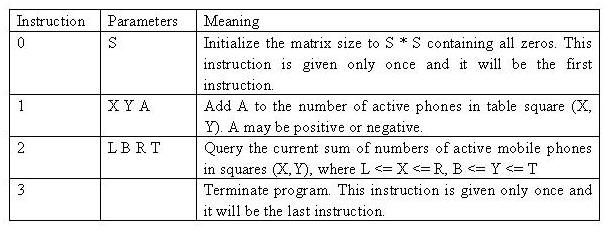POJ 1195 Mobile phones(二维树状数组)
| Time Limit: 5000MS | Memory Limit: 65536K | |
| Total Submissions: 15968 | Accepted: 7373 |
Description
Write a program, which receives these reports and answers queries about the current total number of active mobile phones in any rectangle-shaped area.
Input

The values will always be in range, so there is no need to check them. In particular, if A is negative, it can be assumed that it will not reduce the square value below zero. The indexing starts at 0, e.g. for a table of size 4 * 4, we have 0 <= X <= 3 and 0 <= Y <= 3.
Table size: 1 * 1 <= S * S <= 1024 * 1024
Cell value V at any time: 0 <= V <= 32767
Update amount: -32768 <= A <= 32767
No of instructions in input: 3 <= U <= 60002
Maximum number of phones in the whole table: M= 2^30
Output
Sample Input
0 4 1 1 2 3 2 0 0 2 2 1 1 1 2 1 1 2 -1 2 1 1 2 3 3
Sample Output
3 4
Source
#include<iostream>
#include<algorithm>
#include<stdio.h>
#include<string.h>
#include<stdlib.h>
using namespace std;
const int maxn = 1025;
int n,id;
int c[maxn][maxn];
int lowbit(int x)
{
return x&(-x);
}
void updata(int i,int j,int k)
{
while(i<=n)
{
int pj = j;
while(pj<=n)
{
c[i][pj] += k;
pj += lowbit(pj);
}
i += lowbit(i);
}
}
int getsum(int i,int j)
{
int sum = 0;
while(i>0)
{
int pj = j;
while(pj>0)
{
sum += c[i][pj];
pj -= lowbit(pj);
}
i -= lowbit(i);
}
return sum;
}
int main()
{
scanf("%d%d",&id,&n);
int x,y,z,xx,yy;
while(scanf("%d",&id)!=EOF)
{
if(id == 3)
{
break;
}
if(id == 1)
{
scanf("%d%d%d",&x,&y,&z);
x++;
y++;
updata(x,y,z);
}
else if(id == 2)
{
scanf("%d%d%d%d",&x,&y,&xx,&yy);
x++;
y++;
xx++;
yy++;
printf("%d\n",getsum(xx,yy)-getsum(x-1,yy) - getsum(xx,y-1) + getsum(x-1,y-1));
}
}
return 0;
}
郑重声明:本站内容如果来自互联网及其他传播媒体,其版权均属原媒体及文章作者所有。转载目的在于传递更多信息及用于网络分享,并不代表本站赞同其观点和对其真实性负责,也不构成任何其他建议。





































